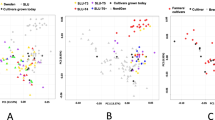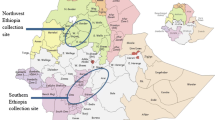Abstract
The potato crop originated in the Andean highlands where numerous farmer's varieties and non-cultivated wild species exist. An Andean potato collection is held in trust at the International Potato Center (CIP) to preserve the biodiversity of this crop and ensure the supply of germplasm for potato improvement worldwide. A core collection representing the biodiversity of the Andean potato germplasm is under construction using morphological, molecular, and geographic data. One of the eight cultivated potato species, Solanum phureja, has been genotyped using the RAPD technique. A protocol suitable for large germplasm collection genotyping has been developed to process numerous samples at reasonable costs. From 106 RAPD primers evaluated, we have selected 12 primers yielding 102 polymorphic markers, which unambiguously discriminated all 128 accessions but 2 that are possible duplicates. The S. phureja germplasm collected throughout the Andean countries appears to have a homogeneous genetic constitution. There was no clear geographic pattern as indicated by cluster analysis of the RAPD data. A sub-group of 20 accessions has been identified on the basis of the marker data and selected to maximize molecular (RAPD) variance and polymorphism. The probability of capturing equal amounts of marker polymorphism in this sub-group of 20 accessions by random sampling is less than 40%. This set accessions represents our first group of accessions that may constitute a core of the S. phureja collection. This tentative core will be challenged for diversity content by alternate markers and agronomic traits. Hence, the methodology for sampling less than 10% of the base collection, proposed for core collections by Brown (1989), can be based on molecular marker data provided cost-efficient fingerprints are developed.
Similar content being viewed by others
References
Brown, A.H.D., 1989. Core collections: a practical approach to genetic resources management. Genome 31: 818–824.
Brown, A.H.D., 1995. The core collection at the crossroads. In: Hodgkin, T., A.H.D. Brown, Th.J.L. van Hintum & E.A.V. Morales (Eds), Core Collections of Plant Genetic Resources, Wiley-Sayce Publication, United Kingdom, pp. 3–19.
Cañizares, C.A. & G.A. Forbes, 1995. Foliage resistance to Phytophthora infestans (Mont.) de Bary in the Ecuadorian national collection of Solanum phureja subsp.. Juz. & Buk. Potato Res. 38: 3–10.
Cisneros, P.L. & C.F. Quiros, 1995. Variation and phylogeny of the triploid cultivated potato Solanum chaucha Juz. Buk. Based on RAPD and isozyme markers. Genet. Resour. Crop Evol. 42: 373–386.
De Maine, M.J., C.P. Carrol, H.E. Stewart, R.M. Solomon & R.L. Wastie, 1993. Disease resistance in Solanum phureja and diploid and tetraploid S. tuberosum x S. phureja hybrids. Potato Res. 36: 21–28.
Demeke, T., L.M.T. Kawchuck & D.R. Lynch, 1993. Identification of potato cultivars and clonal variants by random amplified polymorphic DNA analysis. Am. Potato J. 70: 561–570.
Doyle, J.J. & J.L. Doyle, 1990. Isolation of DNA from small amounts of plant tissues. BRL Focus 12: 13–15.
Ghislain, M., D. Zhang & M. Herrera-Montoya (Eds), 1997. Molecular Biology Laboratory Protocols: Plant Genotyping. Genetic Resources Department, training manual, CIP, 1997, Lima, Peru.
Hamon, S., S. Dussert, M. Noirot, F. Anthony & T. Hodgkin, 1995. Core collections – accomplishments and challenges. Plant Breeding Abstracts 65: 1125–1133.
Hawkes, J.G., 1992. Biosystematics of the potato. In: Harris, P. (Ed.), The Potato Crop, Chapman & Hall, London, pp. 13–64.
Huamán, Z., A. Golmirzaie & W. Amoros, 1997. The Potato. In: Fuccillo, D., L. Sears & P. Stapleton (Eds), Biodiversity in Trust, Cambridge University Press, Cambridge, pp. 21–28.
Kresovich, S., J.G.K. Williams, J.R. McFerson, E.J. Routman & B.A. Schaal, 1992. Characterization of genetic identities and relationships of Brassica oleracea L. via random amplified polymorphic DNA assay. Theor. Appl. Genet. 85: 190–196.
Milbourne, D., R.C. Meyer, A.J. Collins, L.D. Ramsay, C. Gebhardt & R. Waugh, 1998. Isolation, characterization and mapping of simple sequence repeat loci in potato. Mol. Gen. Genet. 259: 233–245.
Mori, M., K. Hosaka, Y. Umemura & C. Kaneda, 1993. Rapid identification of Japanese potato cultivars by RAPDs. Jpn. J. Genet. 68: 167–174.
Nienhuis, J., J. Tivang & P. Skroch, 1994. Analysis of genetic relationships among genotypes based on molecular marker data. In: Proceedings of the Symposium Analysis of Molecular Marker Data. Joint Plant Breeding Symposia Series, Am. Soc. Hort. Sci. and Crop Sci. Soc. Am., Minneapolis, MN, pp. 8–14.
Ochoa, C.M., 1990. The Potatoes of South America: Bolivia, Cambridge University Press, Cambridge.
Phippen, W.B., S. Kresovich, F.G. Candelas & J.R. McFerson, 1997. Molecular characterization can partition variation among gene-bank holdings: a case study with phenotypically similar accessions of Brassica oleracera var. capitata L. (cabbage) ‘Golden Acre’. Theor. Appl. Genet. 94: 227–234.
Powell, W., M. Morgante, C. Andre, M. Hanafey, J. Vogel, S. Tingey & A. Rafalski, 1996. The comparison of RFLP, RAPD, AFLP and SSR (microsatellite) markers for germplasm analysis. Mol. Breeding 2: 225–238.
Quiros, C.F., R. Ortega, L. van Raamsdonk, M. Herrera-Montoya, P. Cisneros, E. Schmidt & S.B. Brush, 1992. Increase of potato genetic resources in their center of diversity: the role of natural outcrossing and selection by the Andean farmer. Genet. Resour. Crop Evol. 39: 107–113.
Quiros, C.F., A. Ceada, A. Georgescu & J. Hu, 1993. Use of RAPD marker in potato genetics: segregations in diploid and tetraploid families. Am. Potato J. 70: 35–42.
Sambrook, J., E.F. Fritsch & T. Maniatis, 1989. Molecular Cloning: A Laboratory Manual, 2nd ed., Cold Spring Harbor Laboratory Press, Cold Spring Harbor, NY.
Skroch, P., J. Tivang & J. Nienhuis, 1992. Analysis of genetic relationships using RAPD marker data. In: Application of RAPD Technology to Plant Breeding, Crop Science Society of America, Madison, WI, pp. 26–30.
Skroch, P. & J. Nienhuis, 1995. Impact of scoring error and reproducibility of RAPD data on RAPD based estimates of genetic distance. Theor. Appl. Genet. 91: 1086–1091.
Skroch, P., J. Nienhuis, S. Beebe, J. Tohme & F. Pedraza, 1998. Comparison of Mexican common bean (Phaseolus vulgaris L.) core and reserve collections. Crop Sci. 38: 488–496.
Smith, J.S.C., E.C.L. Chin, H. Shu, O.S. Smith, S.J. Wall, M.L. Senior, S.E. Mitchell, S. Kresovich & J. Ziegle, 1997. An evaluation of the utility of SSR loci as molecular markers in maize (Zea mays L.): comparisons with data from RFLP and pedigree. Theor. Appl. Genet. 95: 163–173.
Sneath, P.H.A. & R.R. Sokal, 1973. Numerical taxonomy. The principles and practice of numerical classification. W.H. Freeman, San Francisco, CA.
Spagnoletti Zeuli, P.L. & C.O. Qualset, 1993. Evaluation of five strategies for obtaining a core subset from a large genetic resource collection of durum wheat. Theor. Appl. Genet. 87: 295–304.
Spooner, D.M., J. Tivang, J. Nienhuis, J.T. Miller, D.S. Douches & A. Contreras-M, 1996. Comparison of four molecular markers in measuring relationships among the wild potato relatives Solanum section Etuberosum (subgenus Potatoe). Theor. Appl. Genet. 92: 532–540.
Spooner, D.M., M.L. Ugarte & P.W. Skroch, 1997. Species boundaries and interrelationships of two closely related sympatric diploid potato species, Solanum astleyi and S. boliviense, based on RAPDs. Theor. Appl. Genet. 95: 764–771.
Tanksley, S.D. & S.R. McCouch, 1997. Seed banks and molecular maps: unlocking genetic potential from the wild. Science 277: 1063–1066.
Thormann, C.E., M.E. Ferreira, L.E.A. Camargo, J.G. Tivang & T.C. Osborn, 1994. Comparison of RFLP and RAPD markers to estimating genetic relationships within and among cruciferous species. Theor. Appl. Genet. 88: 973–980.
Weeden, N.F., G.M. Timmerman, M. Hemmat, B.E. Kneen & M.A. Lodhi, 1992. Inheritance and reliability of RAPD markers. In: Application of RAPD Technology to Plant Breeding, Crop Science Society of America, Madison, WI, pp. 12–17.
Williams J., M. Hanafey, A. Rafalski & S. Tingey, 1993. Genetic analysis using amplified polymorphic DNA markers. Methods Enzymol. 218: 704–740.
Author information
Authors and Affiliations
Corresponding author
Rights and permissions
About this article
Cite this article
Ghislain, M., Zhang, D., Fajardo, D. et al. Marker-assisted sampling of the cultivated Andean potato Solanum phureja collection using RAPD markers. Genetic Resources and Crop Evolution 46, 547–555 (1999). https://doi.org/10.1023/A:1008724007888
Issue Date:
DOI: https://doi.org/10.1023/A:1008724007888




